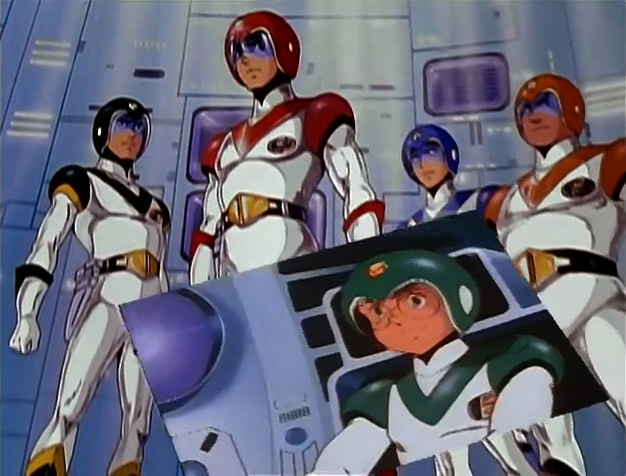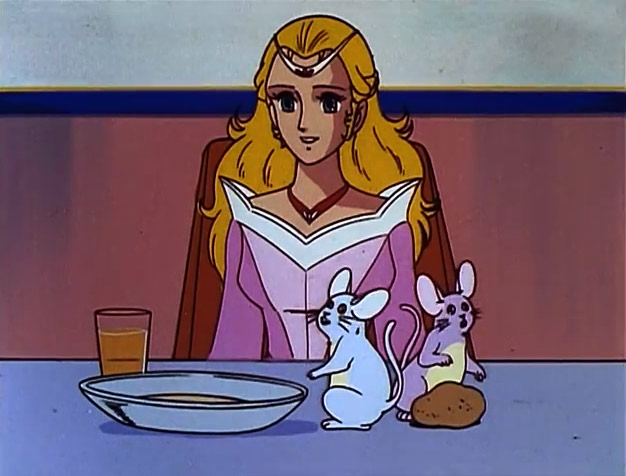 The Voltron Force When TV distribution syndicates upgraded from film to videotape, the colours and sound of anime made a big splash and Voltron led the way.
The Voltron Force When TV distribution syndicates upgraded from film to videotape, the colours and sound of anime made a big splash and Voltron led the way.
Following the Japananese sentai (battle team) tradition, the Voltron Force wear multi-coloured uniforms and are more archetypes than complete characters: the leader, the rebellious sidekick, the big guy, the boy wonder and a girl or two. They combine their futuristic vehicles to form the giant robot Voltron and do battle with massive, mechanical 'RoBeasts.'
Sentai serials are a well-established genre in Japanese television and they sell an awful lot of toys. My interest is mostly in the shows themselves; sentai is sci-fi after all and formula is kept fresh in the creative ways these programmes differ from each other. Voltron puts the similarities and differences into sharp relief.
A pair of sentai anime programmes were combined to form Voltron: their Japanese titles were Armoured Fleet Dairugger XV and GoLion, King of Beasts. In the latter, the vehicles are lion-shaped robots that run and fly about. In both shows the influence of Gerry Anderson's Thunderbirds is felt: the teams ride special chutes directly into the cockpits of their ships.
In contrast to grisly American fare for older viewers, anime programmes in the States were invariably softened into 'cartoons.' Gruesome imagery cut was from running time, with character deaths omitted in dialogue. Doomed hordes of enemy guards and pilots are conspicuously identified – sometimes self-identified – as robots.
Another odd edit – at the end of the Dairugger episodes – serves to tie the two programmes together. It's a re-used clip of the boy Dairugger pilot reading a letter, only this time it's an introductory message from his brother, who we are told is the youngest of the GoLion pilots.
The GoLion episodes were the top favourite of kids, if not with teen me. The mighty Dairugger robot was demoted to 'Voltron III' in toy stores, with the go lions ('go' means 'five' in Japanese) branded 'Voltron I.'
The mysterious 'Voltron II' toys were from a third anime series: Lightspeed Lightning God Albegas. It was initially slated for dubbing but new episodes of GoLion-style Voltron were commissioned instead. Unfortunately, the style and skill of the original GoLion animations was painfully absent from the supplements.
The sci-fi designs and combat action of the initial 104 episodes gripped me as a teenager but I didn't care for Voltron's formulaic storylines. So why did every spare corner of my videotape collection end up full of this stuff? Availability.
As a cable television subscriber in Connecticut I had access to dozens of broadcast channels trailing from Boston, Massachusetts down to New York City. I also happened to have a pair of VCRs and was a past master at programming their timers. Three stations ran Voltron morning and afternoon, making a total of 41 episodes available per week.
 Alura and the Space MiceThe episode I have the most copies of happens to be my least favorite. It's devoted to the Space Mice: little creatures that got up to mischief and hijinks, occasionally helping the Voltron Force save the day. Naturally, the broadcasters kept scheduling that episode because the young'uns loved it.
Alura and the Space MiceThe episode I have the most copies of happens to be my least favorite. It's devoted to the Space Mice: little creatures that got up to mischief and hijinks, occasionally helping the Voltron Force save the day. Naturally, the broadcasters kept scheduling that episode because the young'uns loved it.
Going back through my tapes, I find more value in interesting 80's commercials than in Voltron but to be fair, the giant robots themselves are still pretty cool to me. Voltron was impressive for its time and was the first show of its kind to be made in stereo.
The Space Mice fans have carried their big love for the series forward. I particularly like the look of Voltron: Legendary Defender. The mighty robot fits together better and the Voltron Force are more distinct from each other. Princess Alura and Minister Coran – who've always been inhabitants of the far-flung planet Arus – are clearly alien life forms now. And based on the fandom that surrounds them, they must be loads of fun as characters. Nice one, Voltron LD – seeing parts of my past doing okay is a warm feeling.
